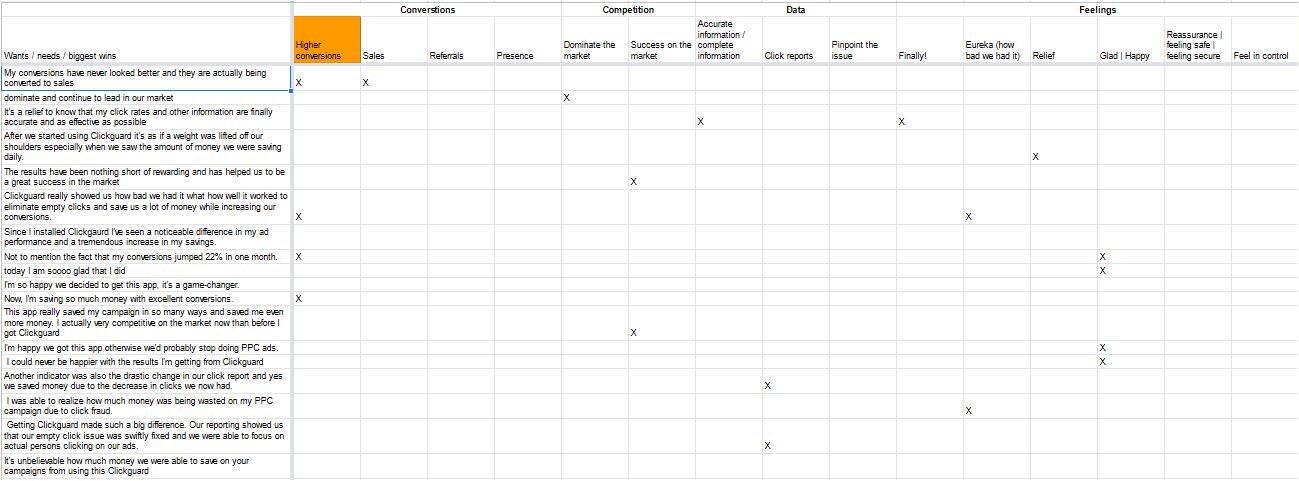How ClickGUARD got a 16% lift
in conversions and identified its best-fit offer
Long-form blog post optimization for organic traffic conversions
ClickGUARD has been consistently publishing content educating readers about click fraud and related topics since 2016. Some of the content pieces, including the What is click fraud (or WICF) long-form blog post, were ready for an update. For WICF, the goal of the update was to bring in more organic visitors and convert them to prospects.
The questions we needed to answer to optimize the post were:
What is currently missing from the post?
How can this post be different from similar posts published by competitors?
What do the problem-aware prospects need to know to move to the solution-aware and then to the product-aware and most-aware stages?
Are there any objections or beliefs that are preventing prospects from moving to the next stage of awareness?
What is the offer that’s most likely to convince the prospects to convert?
“We needed to drive more organic traffic to our website and were looking for a contractor to rewrite and optimize one of our key posts and additional evergreen content pieces. I decided to hire Ekaterina because of her organizational and communication skills and her research capabilities.”
Our process:
Research
Heuristic analysis
Competitor messaging analysis
Review mining
VoC mining on forums
Interviews with the client
Writing & editing
Content reorganization for stages of awareness
External and internal links to increase content credibility
Adding videos
Breakouts with the offer throughout the page
Results & next steps
Identifying the winning offer
Validating assumptions about messaging that would resonate with ICPs
Next steps to improve UX and update the page for more conversions
New questions to explore
ClickGUARD’s WICF post: top-of-the-page heatmap
Research and discovery: key findings
Heuristic analysis of the existing post
Competitor messaging analysis
Review mining
Forum mining
Interviews with the client
Existing post: content analysis
We uncovered the following opportunities:
Organizing existing content to drive readers through stages of awareness
Organizing the information for easy scanning
Adding section-level jump links
Breaking down content into readable segments
Benefits of using a click fraud protection product: in the solution-aware section, showing the challenges of using DIY solutions (possible, but not always feasible)
Differentiation: highlighting differentiators and educating prospects on their benefits
Offer: optimizing based on hypotheses about the ICPs
Competitor messaging analysis
Competitor research showed that similar content was published by all of the competitors, in one form or another. This meant that the updated post needed to offer more than an average post published by competitors.
Competitor homepage messaging analysis revealed that there was also an opportunity for differentiation by educating prospects on different types of fraudulent clicks and tying that information to ClickGUARD’s primary features.
Review mining and forum mining
Research and interviews with ClickGUARD uncovered that problem-aware ICPs had different attitudes towards the topic of click fraud, due to their different levels of understanding of the problem. For the less-educated audience, the claims made by competitors were more attractive by virtue of overcoming one of the prevalent hesitations: a complex setup and the need to be more “technical.”
Additionally, forum mining revealed that click fraud can be a controversial topic. Some examples of click-fraud-related VoC:
“I think I need protection from click fraud” (or, “Is this click fraud?”)
“Why does click fraud exist?”
“Are click fraud protection solutions legit/worth it?”
ICPs with a low level of understanding of the problem would also believe that only select industries are affected by click fraud: “Click fraud is not a problem for our business.”
ICPs with a high level of understanding of the problem were more likely to be aware of the scope of the problem, but one of the beliefs stopping them from acting was that losing some of the ad budget to click fraud is a cost of running ads.
The goal of the What is click fraud post for prospects at this stage was to overcome those beliefs preventing the prospects from looking for a solution — and introduce them to different ways they can protect their ad accounts from fraudulent clicks..
Review mining showed that the biggest challenges that prompted existing users of click fraud products to start using them were:
Getting inaccurate click and performance data
Losing money on fake clicks (“drain budget,” “budget going down the pipe,” “huge chunk of money goes to competitors” etc.)
Desperation to solve a problem they’ve learned about “the hard way”
Not getting ad results or low performance
Review mining: the biggest challenges that prompted existing users of click fraud products to start using them
Review mining: objections to using a click fraud protection product
Review mining: biggest wins from using a click fraud protection product
Review mining also showed that the following objections were most prevalent among users that did convert:
Past experiences with products that didn’t deliver on promises
Difficulty setting up or finding product overwhelming
Similarly, reviews provided an insight into what customers saw as the biggest wins:
Efficiency
Savings
Higher conversions on ads
Getting ready to optimize the post: our hypotheses
Based on the information from the research and discovery phase, these were our hypotheses:
Problem-aware prospects: need to believe that the problem they are experiencing is real and directly attributable to click fraud — and can be solved
Solutions-aware prospects: need to believe that using a click fraud protection product is going to be more effective than a DIY solution
Product-aware prospects: need to understand the pros of customizable rules and the cons of an out-of-the-box approach (convenience vs efficiency tradeoff)
Offer: given low conversion rates for the free trial and high conversion rates for the sales team, a free audit offer would lead to a higher conversion rate
Post update and optimization: our to-dos
Based on the data gathered during the research and discovery phase, we made the following changes to the structure:
Reorganized the informational content to follow the stages-of-awareness journey of the prospects
For impulsive readers & scanners, added offer breakout sections
To distinguish ClickGUARD from more impersonal competitors, added videos from key company representatives
Addressed unanswered questions for low-awareness ICPs around existing protections and why they are not as effective as assumed
Provided additional proof points and hyperlinks to information sources to overcome skepticism among problem-aware readers
Validation: what happened after we published the post
Both traffic volume and the time on page increased over the testing period, and the page got a 16% lift in free trial conversions from organic traffic landing on the page.
The fact that there are more conversions for a free trial means that by the time the prospects are through the page, they have enough information to decide to sign up instead of doing a free audit — if their pain is burning enough.
For the organic traffic that’s not ready to implement a solution, it may make sense to add a lead magnet offer. Given that ClickGUARD is running webinars, adding a gallery block with past webinars and capturing those not-ready-yet prospects may be a good secondary CTA for the page.
Next steps for post optimization
Here’s what ClickGUARD can do to increase conversions on the page:
Remove the audit offer
Strengthen the CTA by focusing on the winning offer
The following page tweaks can help increase time on page:
Extend the top-of-the page table of contents to include subsection jump links — or include them in the left-side index section
Include the free trial offer at the bottom of the page as the primary offer
Update embedded elements
Unanswered questions for further optimization:
Heatmaps and scroll maps: which page sections are not viewed? How can they be optimized?
If not enough traffic makes it to the bottom of the page, would adding an exit intent pop-up with webinars help capture more of the bouncing traffic?
Click maps: does it make sense to reduce the number of external proof sources to decrease the number of visitors leaving the site from this page?
ICPs: given that the page is optimized for the low-awareness prospects, would adding a link to the webinars below the primary CTA help capture more prospects and encourage them to join the list?
ICPs: did the free trial conversions result in paid customers & if so, what are the plans they’ve converted to? Based on that information, what can we learn about the prospects ready to convert after reading the post? How does this info compare with the existing information about ICP customer journeys?
“I was particularly impressed by the thoroughness of research and her sleuthing. Coordinating the assets to make the project successful was a huge bonus, too. Ekaterina seamlessly integrated herself into the team, and followed up with other contractors and team members.”




